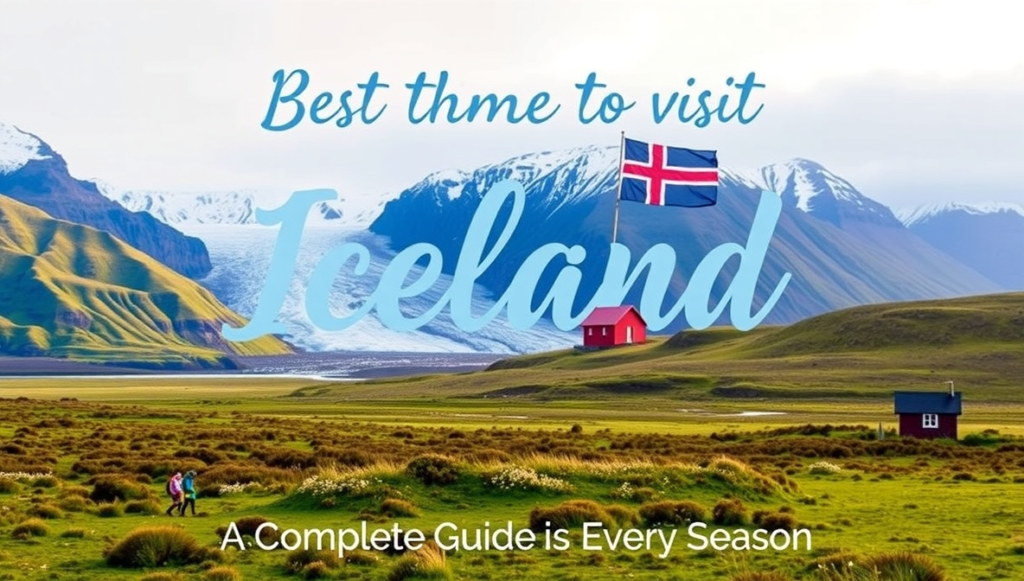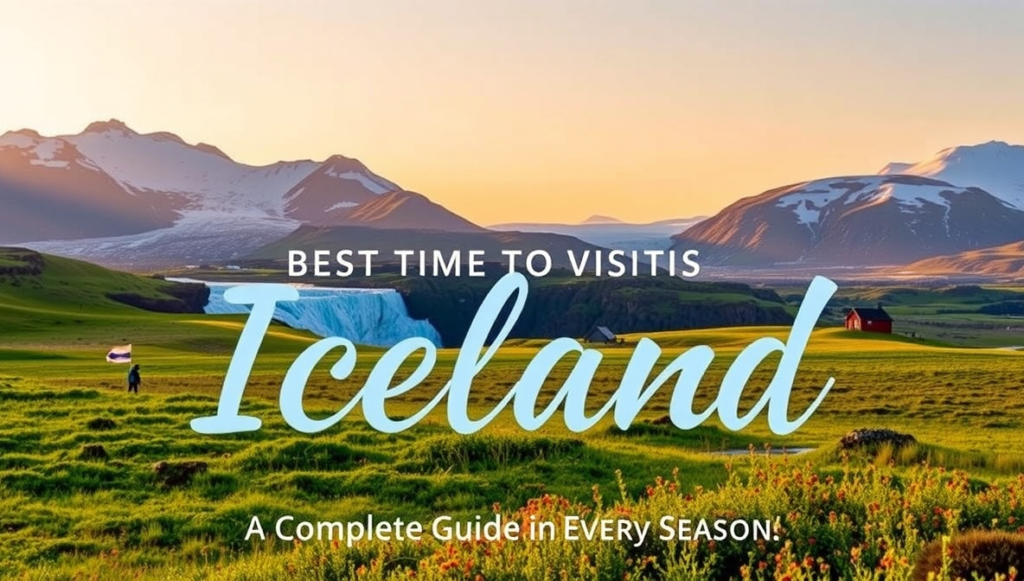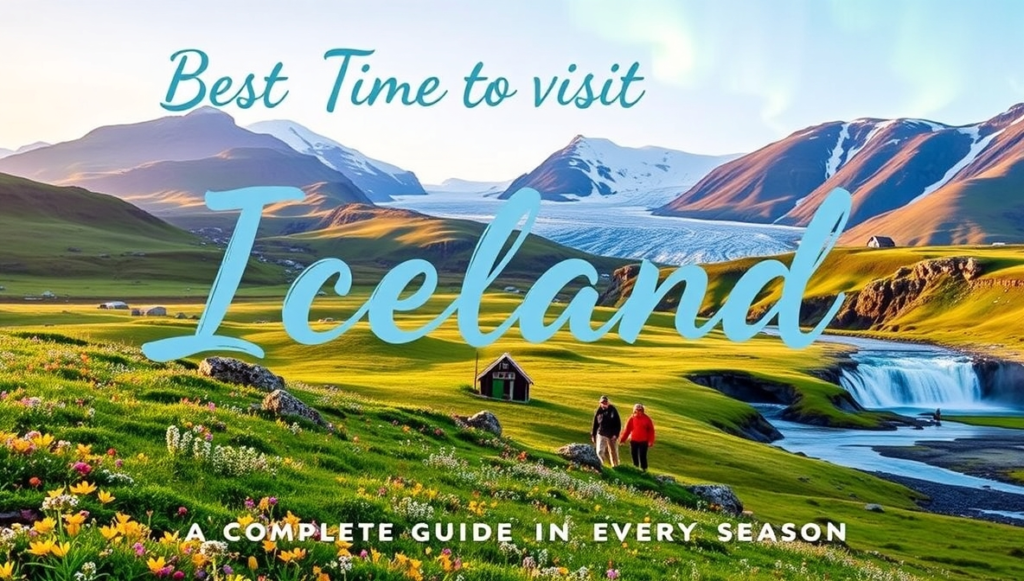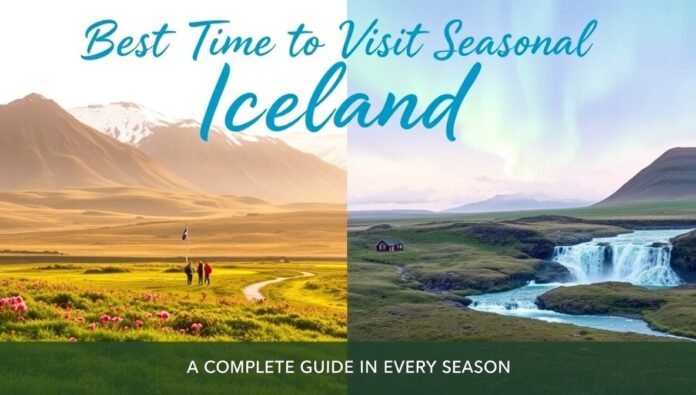Planning your dream trip to Iceland? Then knowing the Best Time to Visit Iceland is the most important thing before you pack your bags. This magical country changes with every season — from glowing summer nights under the midnight sun to dancing northern lights in the winter sky. The best time to visit Iceland really depends on what you want to see and do. Are you dreaming of hiking to waterfalls, relaxing in hot springs, or watching the northern lights swirl above icy landscapes? Each season gives a completely different experience, and that’s what makes Iceland so special. Before you book your ticket, it’s a smart idea to understand what every month offers so you can plan the perfect trip that matches your travel style.
Choosing the best time to visit Iceland also means thinking about weather, crowds, budget, and activities. Summer (June to August) is perfect if you love nature, long days, and road trips because you get nearly 24 hours of daylight. But if your heart is set on seeing the northern lights, then winter (October to March) is your best bet, even though days are much shorter. Spring and autumn are also amazing times to visit because they offer fewer tourists, lower prices, and beautiful scenery with snow and green landscapes mixing together. Whether you want to chase waterfalls, hike volcanoes, or soak in natural hot springs, knowing the best time to visit Iceland will help you plan a trip you’ll never forget.

Best Time to Visit Iceland: Quick Answer for Every Type of Traveler
If you want long days and outdoor adventures, summer (June to August) is the best time to visit Iceland. If you dream of northern lights and winter magic, go between October and March. For fewer crowds and cheaper prices, spring (April–May) and autumn (September–October) are wonderful shoulder seasons. Each season offers unique experiences, so the “best” time depends on your goals, budget, and interests.
Iceland Weather by Season: What to Expect Month by Month
Before booking flights, it’s good to understand Iceland’s weather. The island’s climate is unpredictable — you might see sunshine, rain, and snow all in one day.
- Winter (Oct–Mar): Cold and dark, with average temperatures from -1°C to 4°C. Days are short, but perfect for northern lights and snowy landscapes.
- Spring (Apr–May): Temperatures rise to 5°C–10°C. Days get longer, flowers bloom, and roads become easier to travel.
- Summer (Jun–Aug): Mild weather (10°C–15°C) and up to 24 hours of daylight. Great for hiking, road trips, and nature.
- Autumn (Sep–Oct): Cool weather (4°C–10°C), golden landscapes, and a chance to see northern lights before winter arrives.
Summer in Iceland (June–August): Endless Days and Outdoor Adventures
If you love nature and long days, summer is the best time to visit Iceland. With nearly 24 hours of daylight, you can explore non-stop — from hiking glaciers and climbing volcanoes to chasing waterfalls and camping under the midnight sun. The weather is mild, and most roads, including the famous Ring Road, are fully open. Summer is also festival season, with events like Secret Solstice and National Day celebrations adding local charm.
The only downside? Summer is the busiest and most expensive time to visit. Book flights, hotels, and tours early to avoid high costs and sold-out activities.
Top Summer Activities:
- Explore waterfalls like Skógafoss and Seljalandsfoss
- Hike in Landmannalaugar or Skaftafell
- Go puffin watching and whale spotting
- Road trip around the Ring Road
Winter in Iceland (October–March): Northern Lights and Cozy Experiences
If the northern lights are on your bucket list, winter is the best time to visit Iceland. With long, dark nights, your chances of seeing the aurora borealis are highest. Winter also transforms Iceland into a magical wonderland with frozen waterfalls, icy caves, and snowy mountains. It’s the perfect time for cozy experiences like soaking in the Blue Lagoon surrounded by snow or exploring ice caves inside glaciers.
Winter travel is usually cheaper, but the weather can be harsh, and some roads or regions (like the Highlands) may be closed. Dress warmly and plan flexible itineraries.
Top Winter Activities:
- Northern lights tours
- Visit natural ice caves
- Snowmobile on glaciers
- Relax in geothermal hot springs
Spring (April–May): A Peaceful and Budget-Friendly Time to Explore
Spring is one of the most underrated yet best times to visit Iceland. The days are longer, the snow begins to melt, and wildflowers start blooming across the landscape. Tourist crowds are smaller, making popular sites more peaceful. Flights and hotels are also cheaper compared to summer.
Spring is a great time for birdwatching, including the arrival of puffins, and for exploring waterfalls that are full from melted snow. Road conditions improve, so self-driving trips become easier too.

Top Spring Activities:
- See puffins and migratory birds
- Explore blooming national parks
- Visit waterfalls at their most powerful
- Enjoy peaceful hot springs with fewer tourists
Autumn (September–October): Golden Landscapes and Fewer Crowds
Autumn is another wonderful shoulder season and one of the best times to visit Iceland for travelers who want beauty without the crowds. The landscapes transform into shades of red, orange, and gold, making every photo look magical. Days are still long enough for sightseeing, but nights are dark enough to see the northern lights.
It’s also harvest season, so you can enjoy local food festivals and fresh Icelandic produce. Prices are lower, and you can often find great deals on tours and hotels.
Top Autumn Activities:
- See the northern lights without winter weather
- Capture golden fall landscapes
- Visit geothermal areas and volcanoes
- Join local harvest festivals
Best Time to Visit Iceland for Northern Lights and Magical Skies
The northern lights are one of the main reasons travelers visit Iceland, and the best time to see them is from late September to March. Clear, dark skies are essential — so avoid full moons and check aurora forecasts. Joining a guided tour increases your chances since experts know the best spots and weather conditions.
Best Time to Visit Iceland for Whale Watching and Wildlife Lovers
If wildlife watching is on your list, May to September is the best time to visit Iceland. During this period, humpback whales, minke whales, and dolphins are often seen near the coast. Puffins also nest on cliffs from May to August, making it an ideal time for birdwatching.
Best Time to Visit Iceland for Road Trips and Ring Road Adventures
For road trips, summer (June to early September) is the best time. Roads are open, driving conditions are safe, and daylight lasts nearly all day. You’ll have more freedom to explore remote spots like the Westfjords and the Highlands.
Tips to Choose the Best Time to Visit Iceland Based on Your Budget and Travel Style
- For adventure and nature: Summer
- For northern lights and ice caves: Winter
- For budget travel: Spring or autumn
- For fewer crowds: April–May or September–October

Conclusion
There’s truly no wrong time to explore Iceland — each season offers its own kind of magic. The best time to visit Iceland depends on what you dream of most: endless daylight, dancing northern lights, peaceful landscapes, or thrilling adventures. Plan around your interests, pack for unpredictable weather, and get ready for one of the most unforgettable journeys of your life.
FAQs
Q1: What month is the best time to visit Iceland for the northern lights?
A: The best months are from late September to March, when nights are long and skies are dark.
Q2: Is summer or winter better for Iceland?
A: Both are amazing! Summer is best for nature and road trips, while winter is perfect for northern lights and icy landscapes.
Q3: Is Iceland expensive to visit?
A: Yes, but visiting in spring or autumn can help you save money on flights, hotels, and tours.
Q4: Can you drive around Iceland in winter?
A: It’s possible, but roads can be icy and some regions may be closed. If you’re not used to winter driving, consider joining guided tours.
Q5: How many days are enough for Iceland?
A: A 7–10 day trip is perfect for exploring the main attractions, but even 4–5 days can give you a great experience.


